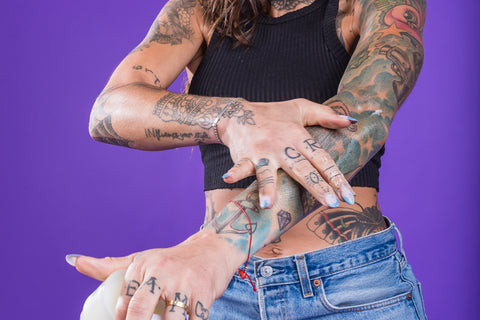A tattoo, once healed, should resemble a vibrant painting seamlessly integrated into your skin. Unfortunately, the emergence of Tattoo Scarring can drastically alter this artistic vision, leading to distortions and textural irregularities that detract from the intended design. Scarring is not a standard part of the tattoo healing journey and understanding how to prevent and manage it is crucial for tattoo enthusiasts.
If you’re currently dealing with tattoo scars, rest assured that there are strategies to minimize their appearance and improve your skin’s texture. This guide will delve into the causes of tattoo scarring, explore available treatments, and emphasize preventative measures to ensure your tattoos heal flawlessly.
Decoding the Causes of Tattoo Scarring
Tattoo scarring primarily stems from two avoidable scenarios. The encouraging aspect is that both are within your control: meticulous artist selection and diligent tattoo aftercare are your strongest defenses against unwanted scars.
One significant cause of tattoo scarring is attributed to inexperienced or unskilled tattoo artists. Techniques such as tattooing too deeply into the skin, applying excessive pressure with the tattoo machine, or repeatedly going over the same area can inflict trauma, increasing the likelihood of noticeable scar tissue formation.
This underscores the paramount importance of investing time in researching and choosing a reputable, experienced tattoo artist. While a friend might offer a tempting “deal” for a home tattoo, remember that entrusting your skin to an amateur is a gamble that could result in long-term scarring and tattoo damage. Professional studios and seasoned artists are equipped with the knowledge and precision to minimize skin trauma during the tattooing process.
However, even with the best artist, improper tattoo aftercare can also lead to scarring. Resist the urge to pick at scabs, peel healing skin, or scratch at your tattoo. These actions prematurely remove the protective top layer of healing skin. This interference can disrupt the skin’s natural repair process, potentially damaging the deeper layers where tattoo ink is deposited, resulting in scars, pitting, and uneven texture within the tattoo.
Can Tattoo Scarring Be Eradicated?
 Close-up of scarred tattoo on arm, highlighting skin texture and ink distortion.
Close-up of scarred tattoo on arm, highlighting skin texture and ink distortion.
Complete scar removal is a complex issue. While scars naturally fade in appearance over time, they rarely disappear entirely. It’s realistic to expect some level of permanent visibility.
Medical interventions such as surgical procedures and laser treatments offer avenues for scar reduction or removal. Scar revision surgery involves excising scar tissue and re-suturing the skin, aiming for a less noticeable scar. Laser treatments can also target scar tissue, breaking it down to improve texture and appearance. However, it’s crucial to understand that these procedures can negatively impact your tattoo. Surgical removal will inevitably cut away portions of the tattooed skin, distorting the design. Laser treatments, while less invasive, can shatter tattoo ink pigments, causing fading and altering the tattoo’s vibrancy as the body absorbs the fragmented ink particles. Therefore, these options are generally not recommended for scar removal within a tattoo unless you are prepared for tattoo alteration or removal.
Tattooing Over Scar Tissue: Is It Possible?
Re-tattooing over existing tattoo scars presents a nuanced situation with outcomes varying case by case. A definitive “yes” or “no” is not always applicable. The feasibility depends on several factors including the scar type, its location, and the condition of the surrounding skin.
Attempting to tattoo over raised scars, such as keloid scars, is generally discouraged. Keloid scars are characterized by thick, raised tissue that extends beyond the original wound boundaries. Tattooing over them will not flatten the scar tissue and may even exacerbate irritation or make the scar more prominent due to the added ink and trauma. The same caution applies to very deep scars. While ink can be deposited into the scarred area, the scar’s depth and textural difference will remain visually apparent, potentially distorting the new tattoo design.
Strategies to Diminish the Appearance of Tattoo Scarring
While complete elimination of tattoo scars without compromising the tattoo itself is often unattainable, various methods can significantly reduce their visibility. The effectiveness of each approach depends on the scar type, severity, and individual skin response.
Silicone Sheets: A Gentle Approach
Silicone sheets offer a non-invasive and readily accessible option for scar management. These sheets work by creating a hydrating and protective barrier over the scar, minimizing friction and promoting a more even skin texture. For optimal results, silicone sheets should be worn for extended periods, ideally almost continuously, removing them only for showering or bathing and reapplying to dry skin.
Patience and consistent application are key with silicone sheets. Noticeable improvements typically require prolonged, daily use for several months, sometimes up to six months or more. Despite the commitment required, silicone sheets are a cost-effective and safe at-home treatment option for minimizing scar appearance.
Dermal Fillers: Seeking Professional Help
For deeper or pitted tattoo scars, dermal fillers administered by a qualified aesthetic dermatologist may offer a solution. These fillers, often used for lip augmentation and wrinkle reduction, can be strategically injected into depressed scars to elevate them to the skin’s surface level.
Dermal fillers commonly consist of hyaluronic acid, a naturally occurring substance in the body. When administered by a licensed professional, they are generally safe. However, their effects are temporary. The volumizing effect of fillers typically lasts from four months to a year, after which repeat injections are necessary to maintain the improved scar appearance. Consider the ongoing cost and commitment before opting for dermal fillers as a scar management strategy.
Proactive Prevention: Avoiding Tattoo Scarring from the Start
 Hands applying moisturizing aftercare cream to a newly tattooed arm to prevent scarring.
Hands applying moisturizing aftercare cream to a newly tattooed arm to prevent scarring.
Prevention is always preferable to correction when it comes to tattoo scarring. Addressing scars after they form is significantly more challenging than taking preventative steps during the tattoo healing process.
Maintaining Optimal Skin Hydration
Keeping your newly tattooed skin adequately moisturized is paramount. Dryness can lead to irritation, cracking, and scab formation. While scabs are a natural part of wound healing, on a tattoo, they can become problematic even if you avoid picking them.
Scabs can trap tattoo ink, potentially pulling pigment away when they detach naturally. They can also adhere to clothing or bedding, and accidental tearing can result in bleeding and, importantly, increase the risk of scarring. Consistent moisturizing helps keep the skin supple, minimizing scab formation and promoting smooth healing.
The Golden Rule: Resist Scratching, Picking, and Peeling
As your tattoo heals, it will naturally go through a flaky or peeling stage. If properly moisturized, it should not develop thick scabs. However, this phase can be intensely itchy. Scratching, picking at flakes, or peeling skin is a major contributor to tattoo scarring. These actions can introduce bacteria, increasing infection risk, and damage the delicate healing skin layers, directly leading to scar tissue formation.
The urge to scratch or peel can be overwhelming when itching intensifies. Consider using a tattoo-numbing cream during the healing phase. While primarily intended for pain relief during tattooing, numbing creams can also effectively alleviate itching sensations. By reducing itchiness, you significantly reduce the temptation to scratch, pick, and peel, protecting your tattoo from potential scarring.
Final Thoughts: Aftercare as Your Best Defense
Diligent tattoo aftercare is your most potent tool in preventing complications like scarring and infections. Adhering meticulously to the aftercare instructions provided by your tattoo artist is non-negotiable.
Our comprehensive aftercare set provides all the essential products to support your tattoo throughout the entire healing journey. And remember, if you are already dealing with tattoo scarring, the strategies outlined above can help you minimize their appearance and regain confidence in your tattooed skin.
Sources:
Scar Revision | Johns Hopkins Medicine
Keloid scar – Symptoms and causes | Mayo Clinic
Hyaluronic Acid: What It Is, Benefits, How To Use & Side Effects | Cleveland Clinic
Everyday Cuts and Scrapes: How to Prevent Scarring | Johns Hopkins Medicine